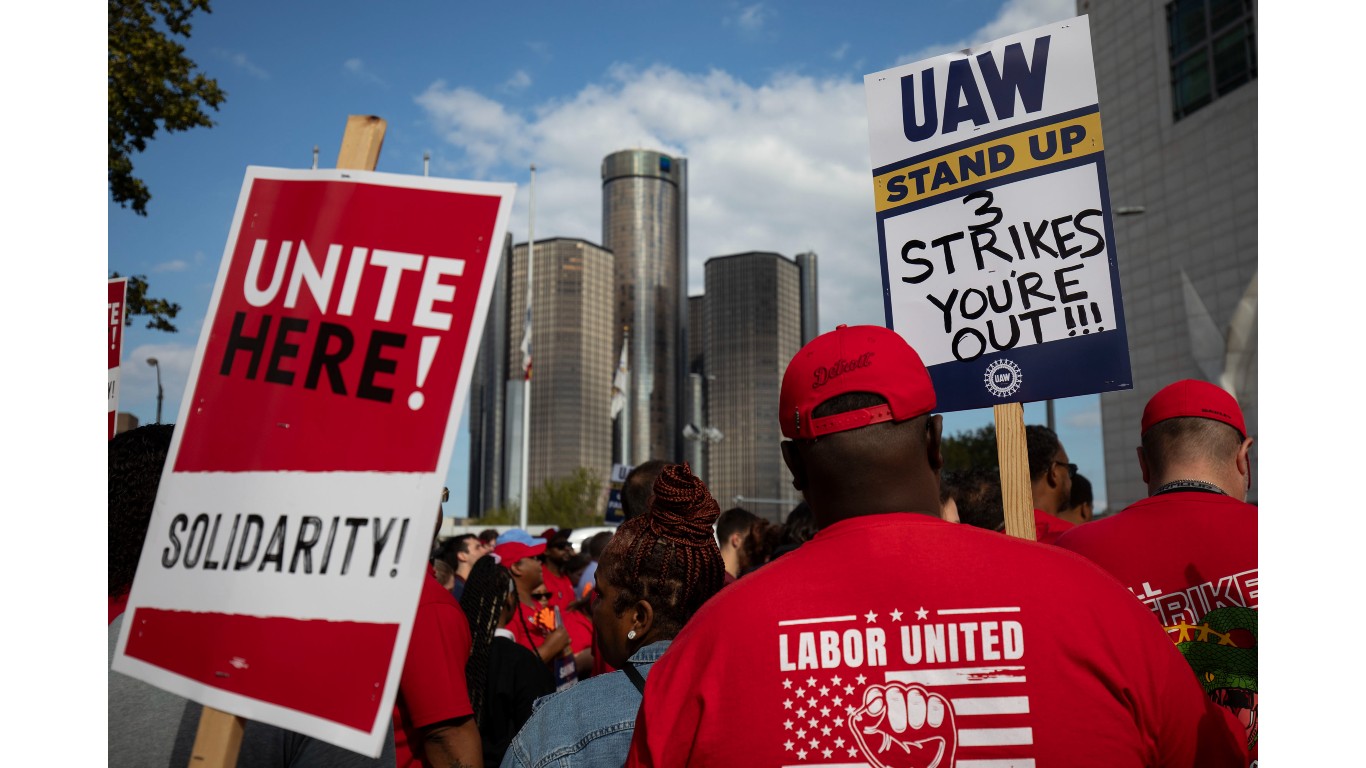Special Report
23 American Industries With the Highest Union Membership Today

Published:

The labor fight that has been pitting writers and actors against film and television producers has halted U.S. movie and TV production. The bitter disputes include issues regarding pay, working conditions, the use of artificial intelligence to supplant actors and writers, and shrinking residual payments that help actors earn income in between projects.
The Writers Guild of America has been on strike since May. The Screen Actors Guild and American Federation of Television and Radio Artists joined the strike in July. (Here are the most significant strikes in Hollywood history.)
Hollywood’s dual strikes, the first in more than six decades, follow a long list of U.S. labor actions in recent years, including from Starbucks employees, Uber and Lyft drivers, and two failed attempts to unionize an Amazon warehouse facility in Bessemer, Alabama, a city in the anti-union South. (Amazon workers in Staten Island were more successful, creating the first unionized workforce at a company warehouse in April, 2021.) In August, a strike by UPS workers was averted when the Teamsters, which represents 340,000 UPS employees, won better pay and benefits on a five-year contract.
Most recently, about 13,000 workers from U.S. automakers Ford, GM, and Stellantis (Chrysler’s parent), took to the picket lines on Sept. 15, in Missouri, Ohio, and Michigan, threatening additional strikes for better pay and benefits. (Foreign automakers have preferred to set up shop in the South, so they face fewer challenges from labor.)
All of this has been described as a “union boom,” but the truth is union representation in the United States is extremely low, and shrinking. The Bureau of Labor Statistics reported that union membership actually declined last year by 0.2 percentage points to a record low 10.1%. In the 1950s, one out of every three nonagricultural workers in the country were card-carriers.
To identify the most unionized industries in America, 24/7 Wall St. reviewed Union Membership, Coverage, Density, and Employment by Industry for 2022 using data from the Union Membership and Coverage Database from the CPS (Unionstats.com). We included all industries where the share of workers who are union members is 20% or higher. (Conversely, here are the American jobs with zero union members last year.)
The most highly unionized U.S. sector is educational services, where nearly 30% of workers are union members and one in three workers are covered by union representation. This includes nearly 3.5 million of the country’s 9 million elementary and secondary school teachers who are part of organized labor.
Public administration is the second-most unionized industry with about 28% union membership. For example, about 41% of the nearly 2.8 million workers involved in justice, public order, and safety activities — a category that includes police officers and firefighters — carry union cards.
In third place: One out of five transportation and warehousing workers are union members. This sector includes rail workers, where more than half are unionized, and postal services workers, where more than 61% of workers are union members and nearly 65% are covered by collective-bargaining agreements.
Here are the most unionized U.S. industries.

23. Electric power generation, transmission and distribution
> Union membership: 20.5%
> Total union members: 141,000 – #16 most out of 262 industries
> Total industry employment: 691,000 -#56 most out of 262 industries
[in-text-ad]

22. Administration of environmental quality and housing programs
> Union membership: 20.9%
> Total union members: 60,000 – #39 most out of 262 industries
> Total industry employment: 286,000 -#108 most out of 262 industries

21. Administration of economic programs and space research
> Union membership: 21.9%
> Total union members: 127,000 – #18 most out of 262 industries
> Total industry employment: 580,000 -#64 most out of 262 industries

20. Iron and steel mills and steel product manufacturing
> Union membership: 22.8%
> Total union members: 61,000 – #38 most out of 262 industries
> Total industry employment: 267,000 -#111 most out of 262 industries
[in-text-ad-2]

19. Pulp, paper, and paperboard mills
> Union membership: 22.9%
> Total union members: 38,000 – #51 most out of 262 industries
> Total industry employment: 164,000 -#134 most out of 262 industries

18. Water, steam, air conditioning, and irrigation systems
> Union membership: 23.4%
> Total union members: 62,000 – #36 most out of 262 industries
> Total industry employment: 266,000 -#112 most out of 262 industries
[in-text-ad]

17. Miscellaneous petroleum and coal products
> Union membership: 23.7%
> Total union members: 6,000 – #159 most out of 262 industries
> Total industry employment: 24,000 -#250 most out of 262 industries

16. Performing arts companies
> Union membership: 23.7%
> Total union members: 31,000 – #57 most out of 262 industries
> Total industry employment: 129,000 -#161 most out of 262 industries

15. Tire manufacturing
> Union membership: 23.9%
> Total union members: 16,000 – #92 most out of 262 industries
> Total industry employment: 68,000 -#207 most out of 262 industries
[in-text-ad-2]

14. Public finance activities
> Union membership: 24.2%
> Total union members: 90,000 – #26 most out of 262 industries
> Total industry employment: 370,000 -#89 most out of 262 industries

13. Sewage treatment facilities
> Union membership: 24.3%
> Total union members: 29,000 – #61 most out of 262 industries
> Total industry employment: 119,000 -#167 most out of 262 industries
[in-text-ad]

12. Psychiatric and substance abuse hospitals
> Union membership: 24.4%
> Total union members: 19,000 – #80 most out of 262 industries
> Total industry employment: 79,000 -#194 most out of 262 industries

11. Not specified utilities
> Union membership: 26.4%
> Total union members: 10,000 – #120 most out of 262 industries
> Total industry employment: 38,000 -#235 most out of 262 industries

10. Administration of human resource programs
> Union membership: 26.4%
> Total union members: 364,000 – #8 most out of 262 industries
> Total industry employment: 1,378,000 -#23 most out of 262 industries
[in-text-ad-2]

9. Aluminum production and processing
> Union membership: 29.0%
> Total union members: 17,000 – #89 most out of 262 industries
> Total industry employment: 57,000 -#218 most out of 262 industries

8. Water transportation
> Union membership: 29.3%
> Total union members: 25,000 – #68 most out of 262 industries
> Total industry employment: 86,000 -#191 most out of 262 industries
[in-text-ad]

7. Electric and gas, and other combinations
> Union membership: 31.6%
> Total union members: 37,000 – #52 most out of 262 industries
> Total industry employment: 117,000 -#168 most out of 262 industries

6. Air transportation
> Union membership: 37.9%
> Total union members: 264,000 – #9 most out of 262 industries
> Total industry employment: 695,000 -#55 most out of 262 industries

5. Elementary and secondary schools
> Union membership: 38.2%
> Total union members: 3,471,000 – #1 most out of 262 industries
> Total industry employment: 9,077,000 -#1 most out of 262 industries
[in-text-ad-2]

4. Bus service and urban transit
> Union membership: 41.2%
> Total union members: 188,000 – #13 most out of 262 industries
> Total industry employment: 457,000 -#71 most out of 262 industries

3. Justice, public order, and safety activities
> Union membership: 41.3%
> Total union members: 1,139,000 – #3 most out of 262 industries
> Total industry employment: 2,756,000 -#7 most out of 262 industries
[in-text-ad]

2. Rail transportation
> Union membership: 54.1%
> Total union members: 125,000 – #19 most out of 262 industries
> Total industry employment: 231,000 -#116 most out of 262 industries

1. Postal Service
> Union membership: 61.3%
> Total union members: 384,000 – #7 most out of 262 industries
> Total industry employment: 626,000 -#63 most out of 262 industries
The last few years made people forget how much banks and CD’s can pay. Meanwhile, interest rates have spiked and many can afford to pay you much more, but most are keeping yields low and hoping you won’t notice.
But there is good news. To win qualified customers, some accounts are paying almost 10x the national average! That’s an incredible way to keep your money safe and earn more at the same time. Our top pick for high yield savings accounts includes other benefits as well. You can earn up to 3.80% with a Checking & Savings Account today Sign up and get up to $300 with direct deposit. No account fees. FDIC Insured.
Click here to see how much more you could be earning on your savings today. It takes just a few minutes to open an account to make your money work for you.
Thank you for reading! Have some feedback for us?
Contact the 24/7 Wall St. editorial team.